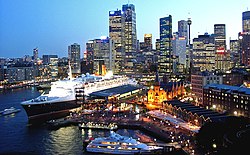 Parts of Circular Quay and The Rocks, administered by the Sydney Harbour Foreshore Authority. | |
| Statutory authority overview | |
|---|---|
| Formed | 1 February 1999 |
| Dissolved | 1 July 2016 |
| Superseding Statutory authority | |
| Jurisdiction | White Bay Power Station, Darling Harbour, The Rocks, Luna Park Sydney, Circular Quay, Rozelle Rail Yards in Sydney, New South Wales |
| Headquarters | 66 Harrington Street, The Rocks, New South Wales |
| Minister responsible | |
| Parent Statutory authority | Department of Finance, Services and Innovation |
| Key document | |
| Website | shfa |
Sydney Harbour Foreshore Authority (SHFA) was a statutory authority that owned and managed some of the Government of New South Wales most significant Sydney harbour foreshore assets, including Sydney's heritage and cultural precincts at The Rocks and Darling Harbour. The Foreshore Authority was also place manager for a number of culturally significant sites in Sydney, including Rozelle Rail Yards, White Bay Power Station and Ballast Point Park.